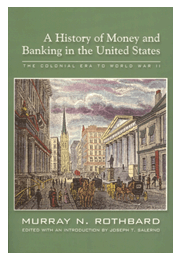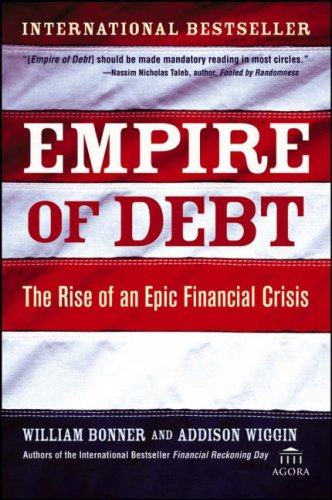
Meltdown: A Free-Market Look at Why the Stock Market Collapsed, the Economy Tanked, and Government Bailouts Will Make Things Worse
By Thomas E. Woods Jr.
Regnery Publishing 2009
194 pages. $27.95
In 1913, just after the Federal Reserve Act passed, Congressman Charles A. Linbergh Sr., whose son would become a world famous aviator, had this to say about the Federal Reserve Act: “This act establishes the most gigantic trust on earth … When the President signs this act, the invisible government by the money power, proven to exist by the Money Trust Investigation, will be legalized … The new law will create inflation whenever the trusts want inflation.”
It’s safe to say that Thomas E. Woods Jr. agrees with Congressman Lindbergh. In the first chapter of his book Meltdown, Woods states bluntly that the Federal Reserve System caused the recent financial meltdown of the U.S. economy. “The Fed’s policy of intervening in the economy to push interest rates lower than the market would have set them was the single greatest contributor to the crisis that continues to unfold before us.”
Woods explains how the crisis took place in his second chapter. He enumerates the culprits. The first were Fannie Mae and Freddie Mac, which lowered lending requirements “in the name of helping ‘disadvantaged’ groups.” The second culprit was the Community Reinvestment Act, which pushed for looser lending requirements “in the name of ‘racial equality’.” Culprit number three was the federal government, which encouraged “relaxed underwriting standards.” Culprit number four was the “pro-ownership” tax code. And the fifth culprit was – you guessed it – the Federal Reserve System, which pushed down interest rates by increasing the money supply. This lured “increasingly reckless or ill-prepared investors into the game.”
The sixth culprit was the “too big to fail mentality,” which has led to the Fed trying to inflate its way out of a recession. Woods calls this approach to the problem “the very worst policy to adopt.” For it will only make the problem worse, prolonging the crisis.
Woods then moves on to discuss The Great Wall Street Bailout. The government’s reaction to the financial meltdown was to nationalize Fannie and Freddie, bailout AIG, bailout the automakers, and bailout the banks. Woods argues that these measures were not necessary. The crisis was “overblown.” But the government felt it “had to do something.” So they did. Their efforts were nothing more or less than a lame and misguided attempt to prop up the system, a system that was very, very sick. And as Woods points out, “Today the Fed [still] thinks pumping in more money and driving interest rates lower still – in other words, more of the same – can solve the problem.”
It has not worked and it won’t work, concludes Woods. “There is no magic wand that can make everyone rich.”
In chapter four, Woods provides an easy-to-understand explanation of boom-bust cycles, which, according to Woods, are unnatural. Boom-bust cycles exist because of artificial manipulation of money supplies. Under normal conditions – which means no monetary tinkering – business cycles go up and down in a healthy manner, which is called supply and demand. “But when the Fed lowers rates artificially, they no longer reflect the true state of consumer demand and economic conditions in general.” This kind of interference is similar to trying crystal meth. The initial stimulation feels good for a while, but then addiction takes over and the situation gets messy real fast.
Woods provides an example of a ‘normal business cycle.’ His example is the dot.com boom, which began in 1995 and fell apart in 2000. He points out that “dramatically rising prices for the factors of production on which the boom depended had to bring it to an end eventually.” Yet the government did react to this normal cycle. This reaction “only postponed what it was trying to avoid, and made the crash worse when it finally came.”
Chapter Five exposes myths about the Great Depression, which most economists use to support massive government spending, make-work programs and increased regulation. Woods, however, shows how the Fed’s busybody meddling actually caused the Great Depression. The Fed “pursued an inflationary policy during the 1920s.” Over an eight year span – from 1921 to 1929 – the money supply increased by 55 percent. When the bottom dropped out in 1929, the government did exactly what it should not have done. “It interfered with the free movement of prices and wages…” With the result that the country suffered economically for 15 years. In other words, by attempting to spend their way out of the Great Depression, the government only exacerbated and perpetuated the depression.
‘Money’ is the title of Chapter Six. And it’s a great chapter, because it explains in simple terms just what money is and where the concept came from. The most important fact Woods teaches about money is this – “It doesn’t originate with government.” Which means “fiat paper money is always parasitic on a previously existing commodity money,” because fiat currency originates with government. Woods goes on to make a sensible case for the gold standard, which is much more compatible with the idea of a free market. From there, Woods proceeds to explain why artificial credit is one of the “great economic superstitions of our time.” Real credit, says Woods, has its foundation in real savings. Which means that making something out of nothing – fiat currency – is unreality. And unreality never works for obvious reasons.
The wisdom Woods offers up in Chapter Seven is delightful. Using very basic and very clear language, he debunks the prevailing notion that “consumer spending drives the economy.” He accomplishes this feat by narrating the difference between consumption and production. Put simply, production makes consumption possible. Therefore, a responsible government encourages production, but does not try to manage it.
Woods then provides his recipe for resolving America’s present financial predicament. First, if a company fails, allow it to go bankrupt. No matter how big it is. Second, get rid of Fannie and Freddie. Third, end government fiscal interference. Fourth, re-examine the need for a Federal Reserve System.
Meltdown is one heck of a good read. Woods’ command of economic theory is sumptuous. Yet he doesn’t get bogged down in highbrow terminology. He keeps it simple and to the point. In fact, his presentation is so lucid it’s hard to imagine anyone dissenting.
![]() On the Read-O-Meter, which ranges from 1 star (why bother) to 5 stars (essential), Meltdown earns 5 stars. This is one book you don’t want to miss.
On the Read-O-Meter, which ranges from 1 star (why bother) to 5 stars (essential), Meltdown earns 5 stars. This is one book you don’t want to miss.



